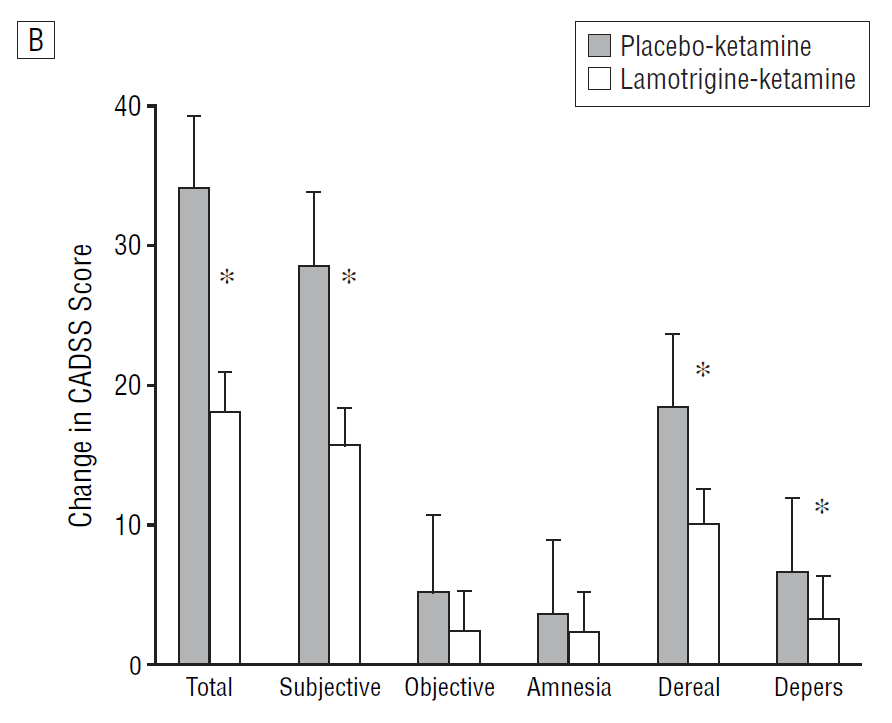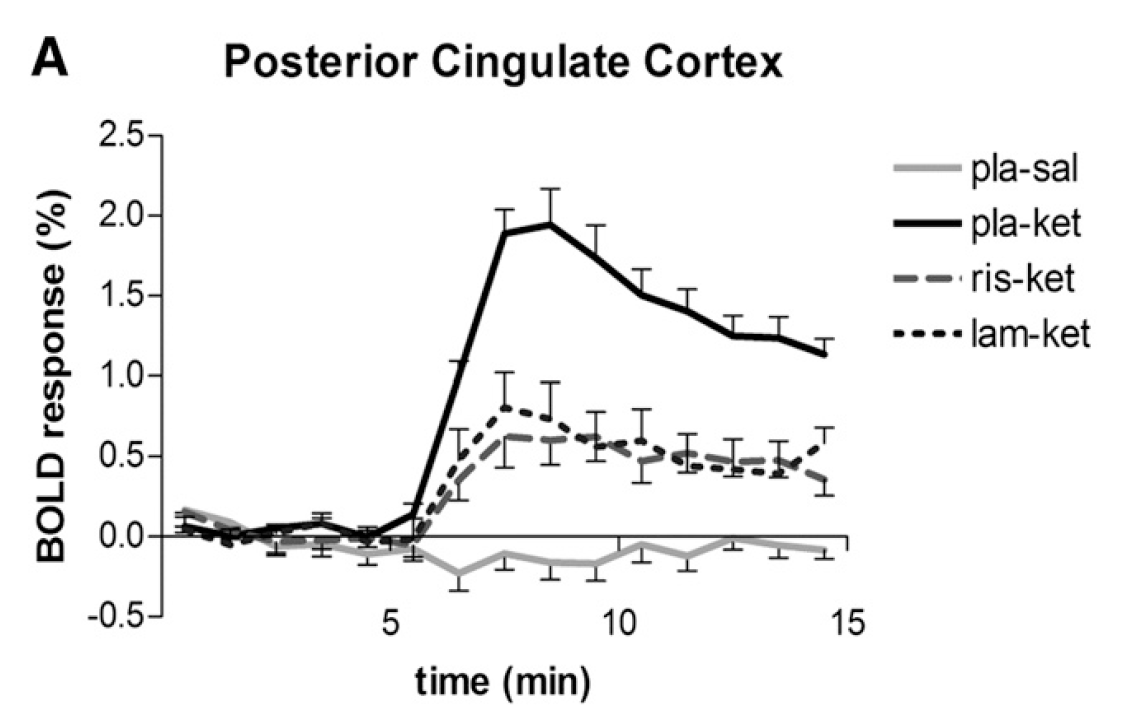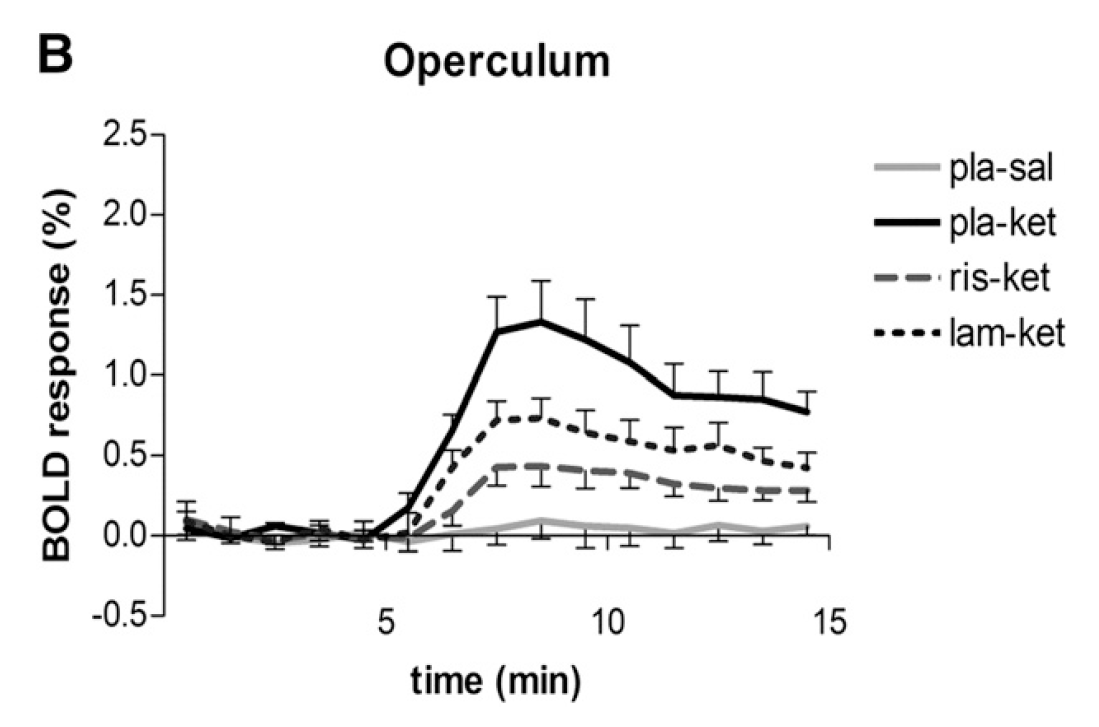by Zinnia Jones —January 28, 2018
Lamotrigine (Lamictal) is an anticonvulsant and mood stabilizer used for treatment of epilepsy and bipolar disorder. It has also been used experimentally in treatment-resistant depression (Thomas et al., 2010), schizophrenia (Premkumar & Pick, 2006), borderline personality disorder (Bellino et al., 2008), and other psychiatric conditions (Reid et al., 2013). Notably, lamotrigine (in combination with serotonergic drugs such as SSRIs or SNRIs) is one of the few medications that has been found to be somewhat effective in depersonalization disorder, a highly distressing dissociative condition considered difficult to treat (Sierra, 2008).
Lamotrigine primarily works by inhibiting the release of glutamate, an excitatory neurotransmitter (Leach et al., 1986). Conversely, ketamine, a dissociative anesthetic and recreational drug, antagonizes the NMDA receptor (a type of glutamate receptor) and increases levels of glutamate (Stone et al., 2012), producing symptoms such as marked depersonalization, derealization, and emotional blunting (Lahti et al., 1995). Via these competing mechanisms, administration of lamotrigine can counteract some of the observed effects of ketamine use.
The effectiveness of lamotrigine in reducing the dissociative symptoms associated with ketamine has been demonstrated in several clinical studies, and at least one case report noted the total ineffectiveness of ketamine as an anesthetic when treating lamotrigine overdose. The involvement of the glutamate system in dissociative symptoms, and the ability of lamotrigine to diminish ketamine’s depersonalizing effects, provide a theoretical basis for lamotrigine’s partial efficacy in the treatment of depersonalization disorder (Sierra, 2008):
Other researchers have suggested that excitatory amino acids such as glutamate might be relevant in general to the pathophysiology of depersonalization and dissociation. For example, subanesthetic doses of ketamine, whose effects might be mediated through increased glutamate release, can induce many of the subjective experiences characteristic of depersonalization, including a sense of detachment and emotional numbing. Interestingly, a recent functional MRI study found that subjects with ketamine-induced depersonalization showed abnormalities in the processing of emotional stimuli, which were similar to those previously reported in patients with DPD. Thus, subjects with ketamine-induced depersonalization and those with DPD showed a lack of activity in limbic areas and hyperactivity in prefrontal cortical regions that may be important for mood regulation. It is believed that ketamine-induced depersonalization is mediated by increased glutamate release in response to NMDA receptor blockade, with a consequent excess of glutamate activity at non-NMDA glutamate receptors. In keeping with this hypothesis, it has been found that pretreatment with lamotrigine, a drug reported to inhibit glutamate release by action at the presynaptic membrane, attenuates the effects of ketamine on conscious experience and cognition.
Literature
Anand et al. (2000) pretreated subjects with either a placebo or a 300mg single dose of lamotrigine two hours before they were given ketamine or a placebo. Compared to pretreatment with placebo, lamotrigine was associated with “a significant decrease in ketamine-induced dissociative symptoms” at 5 minutes and 80 minutes after ketamine administration, as measured by the Clinician-Administered Dissociative States Scale (CADSS). Among other symptoms, the scale measures impairments in body perception and memory, as well as feelings of unreality.

Subjects pretreated with lamotrigine before being given ketamine also showed a reduction in negative symptoms associated with schizophrenia, symptoms which are commonly induced by ketamine. The effects attenuated by lamotrigine included emotional withdrawal and blunted affect, as measured by the Brief Psychiatric Rating Scale (BPRS).

Deakin et al. (2008) administered placebo or 300mg of lamotrigine to subjects two hours before they were given ketamine. Those who were pretreated with lamotrigine showed significantly lower total CADSS scores compared to those given placebo, as well as significantly lower scores on the depersonalization and derealization subscales of the CADSS.

In comparing the fMRI imaging results from the placebo and lamotrigine group, the researchers note that “most of ketamine’s effects were antagonized by lamotrigine”, and conclude that their findings “suggest that the subjective effects of ketamine are mediated by enhanced glutamate release”.
Doyle et al. (2013) pretreated subjects with either 300mg of lamotrigine, 2mg of risperidone (an atypical antipsychotic), or a placebo, before administering either ketamine or saline. fMRI readings of relevant brain areas found that “lamotrigine and the antipsychotic risperidone attenuated the phMRI response to ketamine to a similar degree”.


Kornhall & Nielsen (2014) report the case of a patient displaying severe agitation and violent movements upon admission to the emergency department. Sedation was attempted using a total of 250mg of ketamine over 20 minutes, but there were “no signs of dissociative anesthesia”. Other medications were then used to induce sedation, and the next day, the patient reported that she had overdosed on lamotrigine.
References
- Anand, A., Charney, D. S., Oren, D. A., Berman, R. M., Hu, X. S., Cappiello, A., & Krystal, J. H. (2000). Attenuation of the neuropsychiatric effects of ketamine with lamotrigine: support for hyperglutamatergic effects of N-methyl-D-aspartate receptor antagonists. Archives of General Psychiatry, 57(3), 270–276. [Abstract] [Full text]
- Bellino, S., Paradiso, E., & Bogetto, F. (2008). Efficacy and tolerability of pharmacotherapies for borderline personality disorder. CNS Drugs, 22(8), 671–692. [Abstract]
- Deakin, J. F., Lees, J., McKie, S., Hallak, J. E., Williams, S. R., & Dursun, S. M. (2008). Glutamate and the neural basis of the subjective effects of ketamine: a pharmaco-magnetic resonance imaging study. Archives of General Psychiatry, 65(2), 154–164. [Abstract] [Full text]
- Doyle, O. M., De Simoni, S., Schwarz, A. J., Brittain, C., O’Daly, O. G., Williams, S. C., & Mehta, M. A. (2013). Quantifying the attenuation of the ketamine pharmacological magnetic resonance imaging response in humans: a validation using antipsychotic and glutamatergic agents. Journal of Pharmacology and Experimental Therapeutics, 345(1), 151–160. [Abstract] [Full text]
- Kornhall, D., & Nielsen, E. W. (2014). Failure of ketamine anesthesia in a patient with lamotrigine overdose. Case Reports in Clinical Care, 2014, 916360. [Full text]
- Lahti, A. C., Koffel, B., LaPorte, D., & Tamminga, C. A. (1995). Subanesthetic doses of ketamine stimulate psychosis in schizophrenia. Neuropsychopharmacology, 13(1), 9–19. [Abstract]
- Leach, M. J., Marden, C. M., & Miller, A. A. (1986). Pharmacological studies on lamotrigine, a novel potential antiepileptic drug: II. Neurochemical studies on the mechanism of action. Epilepsia, 27(5), 490–497. [Abstract]
- Premkumar, T. S., & Pick, J. (2006). Lamotrigine for schizophrenia. Cochrane Database of Systematic Reviews, 2006(4), CD005962. [Abstract]
- Reid, J. G., Gitlin, M. J., & Altshuler, L. L. (2013). Lamotrigine in psychiatric disorders. Journal of Clinical Psychiatry, 74(7), 675–684. [Abstract]
- Sierra, M. (2008). Depersonalization disorder: pharmacological approaches. Expert Review of Neurotherapeutics, 8(1), 19–26. [Abstract]
- Stone, J. M., Dietrich, C., Edden, R., Mehta, M. A., De Simoni, S., Reed, L. J., . . . Barker, G. J. (2012). Ketamine effects on brain GABA and glutamate levels with 1H-MRS: relationship to ketamine-induced psychopathology. Molecular Psychiatry, 17(7), 664–665. [Full text]
- Thomas, S. P., Nandhra, H. S., & Jayaraman, A. (2010). Systematic review of lamotrigine augmentation of treatment resistant unipolar depression (TRD). Journal of Mental Health, 19(2), 168–175. [Abstract]
Last updated: Jan 28, 2018
Citation: Jones, Z. (2018, January 28). Lamotrigine counteracts the effects of ketamine via the glutamatergic system. Gender Analysis. Retrieved from https://genderanalysis.net



